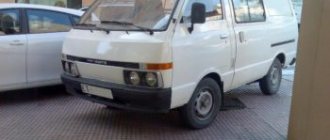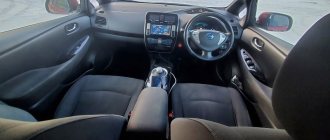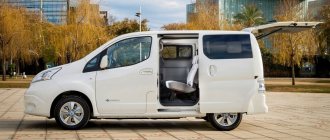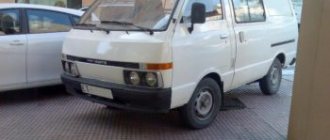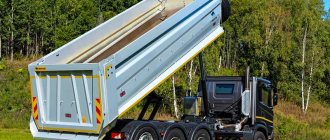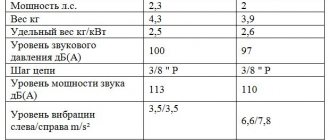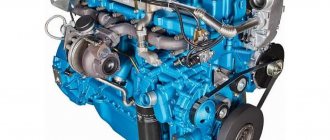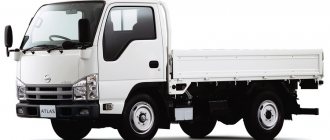Nissan Vanette (other names: Nissan Van, Sunny-Vanette) is a popular cabover minivan produced by a Japanese company since 1978. The model was available in various body styles: small truck, van and minibus with a capacity of up to 8 passengers. In Europe, some modifications of the car were sold under the name Nissan Serena.
The production of Nissan Vanette continued for a long time at enterprises located in Spain and Japan. Production of the minivan ended in 2011. It was replaced in the Nissan lineup by the NV200. However, sales of the Vanette model continue in some countries.
Nissan Vanette is unpretentious and reliable. The car is ideal for traveling in a large group or with family.
Brand history
The triumphant march of the model began in the fall of 1978. Then the Japanese automobile concern released its new brainchild on the roads simultaneously in three body styles. This is a minibus for eight passengers, a cargo van with two passenger seats in the front and a flatbed truck with a double passenger seat in the cabin. The most attractive thing about this car was and remains that it can be driven with a driver's license for a passenger car. From the first days of its existence, the Nissan Vanette has become a reliable assistant among lovers of family holidays and travel, supporters of small businesses and simply an irreplaceable universal car.
Nissan Vanette interior
The developers of the Nissan Vanette were not the pioneers of this class of cars. The idea of a “carriage” for more than 4 passengers simultaneously shrouded many design bureaus in its haze. But after the Mazda team managed to create and launch its Mazda Bongo model into series in 1966, Nissan engineers first had to wait patiently for eleven years until competitors (or like-minded people) had something that they could take as a base for creating your own legend. Creatively and skillfully redesigned.
For Mazda representatives, such a story would amuse their pride. But in the collection of Nissan models there were Nissan Sunny Cab 20 and Nissan Cherry Cab 20 with rear-wheel drive, both born in 1969.
Nissan's collection of models included the Nissan Sunny Cab 20 and Nissan Cherry Cab 20 with rear-wheel drive, born in 1969
They had minor differences, but they laid the foundation for the “Vanka” coverover. Why cab-over? This type of truck layout involves a cab without a hood that sits on top of the engine, which is located above the front axle. Cab 20s were typical cabovers. Many 1st generation Vanettik models traditionally bore the title Cherry or Sunny. Its first representatives came out under the name Datsun C20, then Nissan C20 or Nissan Datsun C20. And only a little later, the entire first generation was united under the Nissan Vanette C120 brand.
While the 1966 Mazda Bongo had a rear engine. Like the “humpbacked” Zaporozhets or Porsche. The engine on the Cab 20 was already located in the area of the front row of seats.
When preparing the Largo model for release, Nissan engineers weighed the car and determined that it would be most optimal if the power unit was pushed 40 cm deep into the cabin and positioned strictly between the front seats and the front axle. Thanks to this, it was possible to achieve balance between the front and rear of the car. The "geographical center" or center of gravity was now on the front axle.
1st generation
Nissan first introduced the Vanette minivan back in 1978. The model replaced the Nissan Cherry Cab (Sunny Cab C20). Initially, 3 modifications of the car were available: a 9-seater minibus (Coach version), a truck and a van with the ability to transport passengers. At the same time, it was possible to drive a Nissan Vanetta with a category “B” driver’s license. The car immediately became very popular in Japan and Europe. The very idea of creating such a model was not new; by that time, many brands had expanded their line with similar machines. The Nissan Vanette has a classic appearance for this class: large round headlights, slightly awkward body lines and a standard bumper.
A year later, the Japanese brand introduced a version with an extended wheelbase. Later, a luxury version of the model with a swivel driver's seat appeared. This solution turned out to be innovative. The evolution of the Nissan Vanette continued. In 1982, further design changes took place: the air conditioning system was improved, front disc brakes and a new instrument panel appeared.
2nd generation
In 1986, the second generation of the minivan premiered. External changes were immediately noticeable. The angular contours of the body have been preserved, but the car has become more proportional and interesting. A line of engines, consisting of injection and carburetor engines with a power of 88-120 hp. replenished with a 2-liter turbodiesel (79 hp). Versions with a 4-speed automatic transmission also appeared. Certain improvements have also been made in the design. The quality of finish has improved, and the model has become easier to operate.
3rd generation
In 1994, the Japanese concern introduced the third generation of the Nissan Vanette. The car remained rear-wheel drive, but the layout became more modern - single-volume. The model was made in the European style, but it retained the outlines of its predecessor. The body received a half-hood layout (the front axle and engine were moved forward of the cabin under the first row of seats). This solution made it possible to make the weight distribution ideal. The vehicle's carrying capacity has also increased slightly - to 535-740 kg, useful volume - to 4.8 cubic meters. Changes also occurred in the motor range. The minivan was offered with a 1.6-liter unit (98 hp), a new 2-liter engine (126 hp) and a 2-liter CD20T diesel engine (66 hp). Improved power plants have made the Nissan Vanette more economical and dynamic. In 1995, a 2.3-liter diesel engine (135 hp) was added to the engine line. The engines were equipped with a 5-speed manual transmission. An optionally modified “automatic” was offered. In the same year, the production of new modifications Vanette Cargo and Vanette Combi began.
4th generation
In 1999, the fourth generation Nissan Vanette was shown to the public. Among the main features of the new product are a simple interior trim, a rounded body design, interesting headlights, a bumper that protrudes forward and an expanded range of engines. The car has remained a reliable and practical vehicle with many different modifications. In Russia, the model was not as popular as in the West.
Nissan Vanette has an almost ideal interior layout, which was developed specifically for transporting cargo and long trips. Despite many modifications, the most popular were passenger and semi-truck models. They are still actively exploited today.
Specifications
| Vanette I | Vanette II | Vanette III | Vanette IV | |
| Start year of release | 1978 | 1985 | 1994 | 1999 |
| Model | S120 | S22 | S20, SE, SK | S21, SK |
| Dimensions, m | 3.9x1.6x1755 | 4.36x1.69x1.9 | 4.365х1.69ъ1.9 | 4.285x1.69x1.985 |
| (Cargo 2.3D) | 4.5x1.695x1.98 | |||
| Clearance, cm | 17 | 15-18,5 | 18,5 | 17 |
| Load capacity, kg | 600-865 | 750-865 | 600-1000 | 750 |
| Turning radius | 4,6-4,9 | 4,3-5,1 | ||
| Tire size | 195/70R15 92Q | 195/70R14 90S | 175/R14-6PRLT | |
| Wheelbase, m | 2,075 | 2,35 | 2,735 | 2,22 |
| Power steering | No | Yes | Yes | Yes |
| Fuel tank, l | 50-55 | 60 | 60 | 53 |
The fact is that any summary and comparative table for the Nissan Vanetta will have inaccuracies. It is simply impossible to unambiguously reflect in it all the moments and various parameters inherent in the palette of models and modifications of this car. Only tables of technical characteristics for each specific model make sense. The Nissan Vanette is truly worthy of a book. Extensive and complete.
Overall dimensions of the basic version:
- length – 4285 mm;
- width – 1690 mm;
- height – 1985 mm;
- wheelbase – 2200 mm;
- front track – 1460 mm;
- rear track – 1465 mm;
- ground clearance - 170 mm;
- minimum turning radius – 5000 m.
The body of the Nissan Vanette can accommodate up to 4.8 cubic meters of cargo. In the Combi version, the passenger capacity is 5-8 people. The carrying capacity of some versions reaches 750 kg, the total weight is 2050 kg.
The minivan stands out for its low fuel consumption. Consumption in the extra-urban cycle is 6.25 l/100 km, in the urban cycle – 10.2 l/100 km. The fuel tank holds up to 53 liters of fuel.
Characteristics of the wheels used: 175/R14-6PRLT.
Are there many disadvantages to the Nissan 2.2 Di diesel (YD22DDT)?
Nissan's 2.2-liter diesel (and its older 2.5-liter variant) debuted in 1998. This engine was designed for direct diesel injection. At first, the distribution injection pump Bosch VP44 was responsible for injection. But already in 2001, this engine was modernized and switched to Common Rail injection, and Denso was chosen as the system supplier.
In all variants, the Nissan YD22DDT turbodiesel has 4 valves per cylinder, but there are no hydraulic compensators in their drive. The timing belt is driven by two double-row chains. Another chain, but on the other side of the timing drive, drives the vacuum pump.
This engine has both a naturally aspirated version and turbocharged options: with a wastegate-controlled turbine or with a controlled geometry.
The Nissan 2.2 Di engine was installed on models for Europe - Almera, Almera Tino, Primera and X-Trail. This engine is also widely known on purely Japanese Nissan models - Expert, Sunny, Pulsar, Wingroad.
On our YouTube channel you can watch disassembly of the YD22DDT engine removed from the 2002 Nissan Almera N16.
You can choose and buy a Nissan gasoline or diesel engine in our catalog of contract engines.
Nissan 2.2 Di engine reliability YD22 DDT)
The turbodiesel from Nissan turned out to be very reliable and durable. But, as often happens, all its breakdowns in our time are associated with its age and savings on maintenance. Often, such savings lead to serious mechanical failures of the motor and the need to replace it with a contract one.
Nissan 2.2 Di engine YD22 DDT) is dull and pulls poorly
Short-term and periodic dips in the power and thrust of a Nissan diesel engine may be associated with a failure of the mass air flow sensor or a malfunction of the boost pressure solenoid valve. Diagnostics or “throwing in” serviceable parts will provide more accurate advice.
Black smoke when the engine is running under load primarily indicates that the fuel mixture is too rich. And it usually becomes rich due to air leaks through weakened intake tract clamps or due to jamming of the EGR valve, which discharges a lot of exhaust gases into the cylinders.
Poor engine starting
One of the possible reasons for poor engine starting due to air in the fuel system is a malfunction of the fuel pump. In general, for minimal control of airing in the fuel system, you need to install transparent tubes before and after the boost pump.
Also, often the cause of poor engine starting can be a tired starter that simply does not turn well.
And if the YD22DDT engine refuses to start at all, then it is worth checking the engine control system relay. This relay is located in the block under the glove compartment. More often, of course, the 2.2 Di engine does not start due to problems with the injection pump.
Mass air flow sensor
A dirty or faulty mass air flow sensor can cause the 2.2 Di engine to consume noticeably more fuel or simply not run. Washing the sensor with a special cleaning agent usually helps.
You can select and buy a flow meter for a Nissan 2.2 Di / dCi diesel engine in our catalog of contract spare parts.
EGR valve
It becomes clogged with soot very quickly, begins to jam and hangs in the open position. Because of this, there is a lot of inert gases and little air in the cylinders, which is why the engine starts to smoke. The valve on the 2.2 Di engine can be simply shut off: to do this, place a blind plate on the flange of the exhaust gas extraction pipe.
You can select and buy an EGR valve for the Nissan 2.2 Di / dCi diesel engine in our catalog of contract spare parts.
Turbine
On Nissan diesel engines with power up to 115 hp. a turbine with a bypass valve is used - Garrett GT1549 or IHI RHF4H (on Nissan X-Trail). On more powerful ones - with controlled geometry - Garrett GT18VNT or GTA1849LV. The bypass valve is actually controlled by the turbine itself - by the excess pressure that is formed in the compressor “scroll”.
The geometry is controlled by a traditional electro-vacuum valve. Usually problems indicating a turbine on a 2.2 Di engine are associated with this valve. It simply fails.
The turbines run well, since they create relatively low boost pressure on a relatively large 2.2-liter engine.
You can select and buy a turbine for the Nissan 2.2 Di / dCi diesel engine in our catalog of contract spare parts.
Timing chain stretching
Powerful-looking double-row timing chains of the YD22DDT engine. A very rough engine idle may indicate stretched chains. You can more accurately determine the stretch of chains using the oscillograms of the camshaft and crankshaft position sensors - there will be a discrepancy between the signals. Practice shows that problems with idle speed appear when the chains are stretched by several millimeters.
In addition, there are times when one of the chains breaks. It grinds the timing cover, and the pistons and valves collide. Experts also say that the hydraulic tensioner does not like changes in oil viscosity and often jams after this, which causes the chain to weaken. The chain begins to rattle and may jump.
It is recommended to replace chains at 200 thousand mileage. At a minimum, with such a mileage you need to listen to it carefully. The chains should be replaced with their hydraulic tensioners, which become clogged or worn out over time.
Vacuum pump circuit
The vacuum pump circuit also requires attention. It can stretch, ring when the engine is running and wear out its sprockets. There is a popular way to tighten it - to do this, loosen the bolts of its tensioner, rest against the tensioner, trying to tighten it.
It also sometimes happens that the tensioner shoe wears out a lot, which also leads to sagging of the chain. In any case, a strong metallic grinding sound indicates a sagging chain.
Often, it is necessary to replace not only the vacuum pump chain and its tensioner, but also a worn drive sprocket.
In addition, it happens that the vacuum pump shaft bearing wears out. It can also be the cause of the squeak. Bearing wear is indicated by play in the pump shaft.
You can select and buy a vacuum pump for the Nissan 2.2 Di / dCi diesel engine in our catalog of contract spare parts.
Injectors
The injectors on the 2.2 Di engine generally work well. If they are heavily worn, they may produce a metallic clattering sound. They can also cause the engine to vibrate strongly at idle.
A clogged and leaking nozzle of such injectors can cause the death of the engine. The fact is that due to very poor atomization, diesel fuel gets to the bottom of the piston, where it burns. The pistons of the 2.2 Di engine cannot withstand such temperature stress and may crack. Often they come for a contract YD22DDT engine precisely after the piston has cracked or melted, and at the same time lifted the cylinder mirror.
You can select and buy injectors for the Nissan 2.2 Di / dCi diesel engine in our catalog of contract spare parts.
Monitoring and adjusting valve thermal clearances
Thermal clearances are adjusted by selecting washers of suitable thickness. Over time, the exhaust valves sag first - their thermal clearances decrease, they no longer fit tightly to the seats, which leads to a decrease in compression.
Also, due to incorrect thermal clearances, the engine operates with an extraneous clattering noise, which goes away as the engine warms up.
Injection pump VP44
We have already talked a lot about the VP44 fuel injection pump many times. The pump is quite troublesome and expensive to repair. A wide variety of breakdowns occur with it, both electrical and mechanical.
The injection pump control unit is located directly on the pump. In addition to the not very durable electronic board, it is also famous for the transistor that controls the fuel supply valve, which is located between the fittings on the injection pump. The transistor burns out due to insufficient cooling due to air leaks, due to poor pumping of the fuel system after replacing the filter, and also if the engine stalls without fuel. In general, since the transistor is cooled by fuel, it burns out quite quickly if there is insufficient cooling. True, they say that the Nissan engine pump ECU is much more durable and durable than the VP44 pump options for other brands.
The automatic injection advance also creates problems. The “automatic machine” is controlled by a separate valve and implements its function using a piston. During long-term operation, the piston begins to jam, which is why the injection timing control is completely or partially disrupted. In this case, the engine begins to operate with severe tractor vibrations and rattling.
The valve that controls the automatic timing device may fail on its own, causing similar problems.
Experts on Nissan YD22 (and YD25) engines advise adding an additional booster pump, because They consider the internal boost pump to be weak. It is also recommended to install a finer fuel filter - up to 10 microns. And also the VP44 will last much longer if it runs on diesel fuel with the addition of two-stroke oil at the rate of 0.5 liters of oil per full tank of fuel.
Also, to extend the life of the VP44 fuel injection pump, you need to monitor the cleanliness of the ground terminal on the engine, the cleanliness of the wire loop to the injection pump and prevent it from chafing.
You can select and buy a fuel injection pump for the Nissan 2.2 Di / dCi diesel engine in our catalog of contract spare parts.
Here, using the links, you can see the availability of specific Nissan Almera, Nissan Primera, Nissan Almera Tino, Nissan X-Trail and other models at the disassembly site and order auto parts from them.
Engine
The power plant in the Nissan Vanette has a longitudinal arrangement. The fourth generation of the car was equipped with a 1.8-liter gasoline unit or a 2.2-liter diesel engine. The latter was replaced in 2003 with a more powerful 2-liter turbodiesel engine.
Characteristics of a gasoline engine:
- working volume – 1.8 l;
- rated power – 66 (90) kW (hp);
- maximum torque – 135 Nm;
- number of cylinders – 4;
- the type of fuel used is gasoline AI-92, AI-95.
Diesel engine characteristics:
- working volume – 2 l;
- rated power – 63 (86) kW (hp);
- maximum torque – 178 Nm.
Fuel consumption
Generation 1 (1978-1988)
Gasoline engines
- 1.2, 70 l. p., manual/automatic, rear
- 1.4, 80 l. p., manual/automatic, rear
- 2.0, 90 l. p., manual/automatic, rear
Diesels
- 2.0, 60 l. p., manual/automatic, rear.
Generation 2 (1985-1994)
Gasoline engines:
- 1.6, 100 l. p., manual/automatic, rear
- 2.0, 90 l. p., automatic/mechanical, full
- 2.0, 130 l. p., automatic, rear/full
- 2.4, 105 l. p., manual/automatic, rear/full.
Diesels
- 2.0, 76 l. p., manual, rear
- 2.0, 91 l. p., manual/automatic, rear/full
- 2.0, 67 l. p., manual/automatic, rear/full
Generation 3 (1994-1999)
Diesels:
- 2.0, 67 l. p., manual, full/rear, consumption – 8.5/7.1 l per 100 km
- 2.3, 75 l. p., manual, rear/full, consumption – 12.7/7.9 l per 100 km
Generation 4 (since 1999)
Gasoline engines:
- 1.8, 95 l. p., manual/automatic, full/rear
- 1.8, 102 l. p., manual/automatic, full
Diesels:
- 2.0, 86 l. p., automatic/mechanical, full/rear
- 2.2, 79 l. p., automatic/mechanical, full/rear.
Nissan Vanette, Urvan, Serena device, maintenance, repair
ENGINE TECHNICAL CONDITION ASSESSMENT An engine is like any other device. has three time intervals. and which it goes through the running-in stage, the normal operation stage and the aging stage. Depending on the service life and operating conditions, the main characteristics of the engine undergo changes due to the processes occurring in the engine. The main characteristics of the engine, by which its condition can be assessed without disassembly, are engine power, specific fuel consumption, specific oil consumption and oil pressure in the system At the break-in stage The engine elements are running in, and this causes a slightly increased specific fuel and oil consumption and a slightly reduced oil pressure in the system. The break-in period is usually set at a mileage of 1000 km, however, the break-in process practically continues and ends after a mileage of about 5000 km. By the end of the break-in period, the specific fuel and oil consumption decreases slightly, and the oil pressure in the system increases slightly. During the break-in period, it is recommended to avoid high loads and pay special attention to the normal functioning of the engine lubrication system. After completion of the running-in process, the stage of normal operation begins. the duration of which depends not only on the design features of the engine and the vehicle as a whole, but also on operating conditions and the degree of compliance with basic vehicle maintenance requirements. During this period, engine power, specific fuel and oil consumption and oil pressure in the system are maintained at approximately the same level, and operation of the car does not cause any special problems. The duration of the trouble-free operation period is up to a mileage of 80-100 thousand km. During operation, due to natural wear and tear, the gaps in the connections of the moving elements of the engine increase, the oil pressure in the system drops slightly, and the specific fuel and oil consumption increases. These processes occur most intensively at the end of the engine warranty period (for Japanese cars during normal operation after a mileage of about 100,000 km ). The question arises: when is engine repair required? The answer to this question can be obtained by determining the condition of the engine according to its main characteristics: control fuel consumption, control oil consumption and pressure, degree of engine power reduction. These parameters are known for each specific car. Specific fuel consumption can be determined by carrying out a special test. The test is carried out on a working car with a full load. Before checking, all components of the car must be warmed up (for example, with a run of 10 km). The test drive is done on a straight section of an asphalt road 5 km long in two directions at a speed recommended by the manufacturer as the most economical mode (in the highest torque mode, usually within 60-80 km/h). It is better to measure fuel consumption using a separate measuring tank, from which gasoline is consumed during a test drive. If the specific fuel consumption increases by more than 15% compared to the guaranteed one, the engine requires repair (under normal conditions in winter, fuel consumption increases by about 10 %). During the operation of the vehicle, the oil pressure in the system gradually decreases due to wear of the rubbing surfaces and an increase in gaps in the mating elements. Such a decrease, in principle, is not a sign of the need for engine repair, unless the pressure drops below the permissible limit. For specific oil consumption, there is the following recommendation if oil consumption exceeds the recommended value (1 liter per 1000 km), the engine requires repair. In practice, the oil pressure in the system can be guided as follows: if the oil pressure warning light lights up when the engine is running at the lowest engine speed, the engine requires repair. The degree of reduction in engine power can be determined by increasing the acceleration time to 100 km/h or by reducing the maximum speed. Tests are carried out under the same conditions as for determining specific fuel consumption, but they are not carried out from a equipped but unloaded vehicle. Significant reduction in maximum speed or significant An increase in acceleration time to 100 km/h indicates the need for engine repair.
The described methods for assessing the technical condition of the engine will help the driver independently determine that the engine requires repair. The type of repair should be determined by an experienced specialist, since this requires fairly high qualifications and experience in work of this type. A simple example; The cylinder head gasket is broken. Simply replacing the gasket may not work. if this breakdown is associated with warping of the surface of the block head, for example due to overheating after installing a new gasket, the situation will repeat, and this will continue until the required flatness of the head parting surface is restored. Contacting an experienced specialist is always cheaper than carrying out repair work in a garage by unqualified personnel.
The book we bring to your attention was written based on a study of materials on Nissan minibuses produced during the period from 1979 to 1992. We used proprietary materials provided by the Sibavtosan department of NPA Sibbioprom, the official dealer for the sale of Nissan cars in the city of Novosibirsk, for which the author expresses sincere gratitude to the specified company.
The book is not an official repair manual for any specific model, since such materials can only be published by the manufacturer of a specific model, but can be used when repairing the models indicated in the table below. The main attention is paid to the design, principles of operation of a particular vehicle system, and techniques fault diagnosis and repair techniques Model specific data is provided in the tables at the end of each chapter. The data given in the tables is taken from official sources, however, for specific models they should be clarified by the factory labels attached to the back of the hood since these parameters may differ slightly from those given, which is due to the configuration of a particular model. The book is intended for owners of Nissan minibuses and station repair personnel Maintenance.
Device
Nissan Vanette belongs to the category of trucks and has a design characteristic of this class. The model is available in the following versions: chassis with cab (Truck), van (Practic and Van), variation with an on-board platform and a small minibus (Combi) with a capacity of 2 to 8 people. The car is popular in families where one of the members has a category B driver's license.
The latest generation of Nissan Vanette is characterized by rounded shapes and a frame design. This arrangement makes the car very stable and durable. The machine confidently transports loads in excess of the declared weight. At the same time, the chassis allows the installation of various body types, which increases the capabilities of the model.
The Nissan Vanetta uses a spring or spring variation as a suspension. The latest versions usually use spring suspension with 2 arms in the front. The drive axle is located at the rear. The basic version is rear-wheel drive, but all-wheel drive modifications are also available. It's quite easy to distinguish them. If the car has rear-wheel drive, then the VN index appears in the name. All-wheel drive is designated in the markings by the letters MN.
The Nissan Vanette's braking system is standard. The latest generations use disc brakes, while earlier versions use drum brakes. The hand brake is of a mechanical type.
The main one for the car is a manual transmission (4- or 5-speed). An automatic transmission is available as an option.
The interior of the Nissan Vanette is very thoughtfully designed. A fairly simple dashboard and a comfortable steering wheel with various adjustments ensure comfortable driving. The driver's seat is adjustable in several directions. All seats are upholstered in velor and have armrests. An additional advantage is the transformable interior, which allows you to free up space or adjust the space for specific purposes.
Among the main disadvantages of the model are:
- slight noise when changing gears;
- weak cardan shaft crosspieces (this problem is typical for all rear-wheel drive cars).
Nissan Vanette owner reviews
- Kirill, Yakutsk. I liked the car, but not without its shortcomings. Overall, the Nissan Vanette is a workhorse with a rugged chassis that can handle any cargo load. I work in retail and needed an inexpensive and roomy van. The car was produced in 2005, with a 2-liter diesel engine producing 86 horsepower. Consumption in the city is around 8-9 liters, outside the city - up to 5-6 liters per 100 km.
- Vladimir, Tyva. I drive a 2009 Nissan Vanette, a car with an energy-intensive suspension and an economical diesel engine. Consumes about 8 liters per 100 km. I have a modification with a 79-horsepower 2.2-liter diesel engine. A car with all-wheel drive confidently passes over bumps, rocks, ruts and other obstacles, despite only 79 forces.
- Nikolay, Irkutsk. Traveled 150 thousand kilometers, the flight is normal. Nissan Vanette is a car for those who need a big car for little money. Economical, comfortable, with a roomy interior and ample cargo compartment. With an 86 horsepower engine (diesel), you can get within 8 liters in the city.
- Bogdan, Kirovsk. I have a 2001 Nissan Vanette minivan, the car is used for cargo transportation. In general, I needed the car for work. I bought it in 2008 on the secondary market. A simple and unremarkable car, suitable for driving around the city, on the highway, and also over rough terrain. I note a good smooth ride and large rolls in corners - however, this was to be expected from a van with a high body and large clearance. The version with a 1.8-liter engine produces 95 horsepower and consumes an average of 10-11 liters in the urban cycle.
- Anton, Ulyanovsk. I have a 2002 Nissan Vanette, with a manual transmission, rear wheel drive and an 86-horsepower diesel engine. I bought it in 2015 at one of the Japanese auctions. This is a versatile vehicle with a large cargo area that can fit just about anything. Even when loaded, consumption does not exceed 8-9 liters.
- Vitaly, Kemerovo. I drive a 2004 Nissan Vanette, a car with an automatic transmission and a 95-horsepower engine. Fourth generation minivan. I praise the car for its high ground clearance and good cross-country ability. The long-travel suspension increases the vehicle's capabilities on light off-road conditions. The high-torque gasoline engine accelerates the minibus to 100 km/h in 14 seconds, fuel consumption is 11 liters in the urban cycle, and up to 8 liters in the extra-urban cycle. The car has an eight-seater interior, sound insulation is at an average level, the noise from the rolling tires, as well as gusts of wind, are clearly audible. Visibility is excellent, as befits the LCV class.
- Dmitry, Krasnoyarsk. This minivan is well adapted to Russian conditions. I have a version with a 1.8-liter 100-horsepower engine, coupled with manual transmission and rear-wheel drive. With such an engine, the minivan quickly accelerates from a stop, so in the city the car confidently stays in the flow of traffic, even among ordinary cars. The 100 horsepower version consumes 10-11 liters per 100 km.
